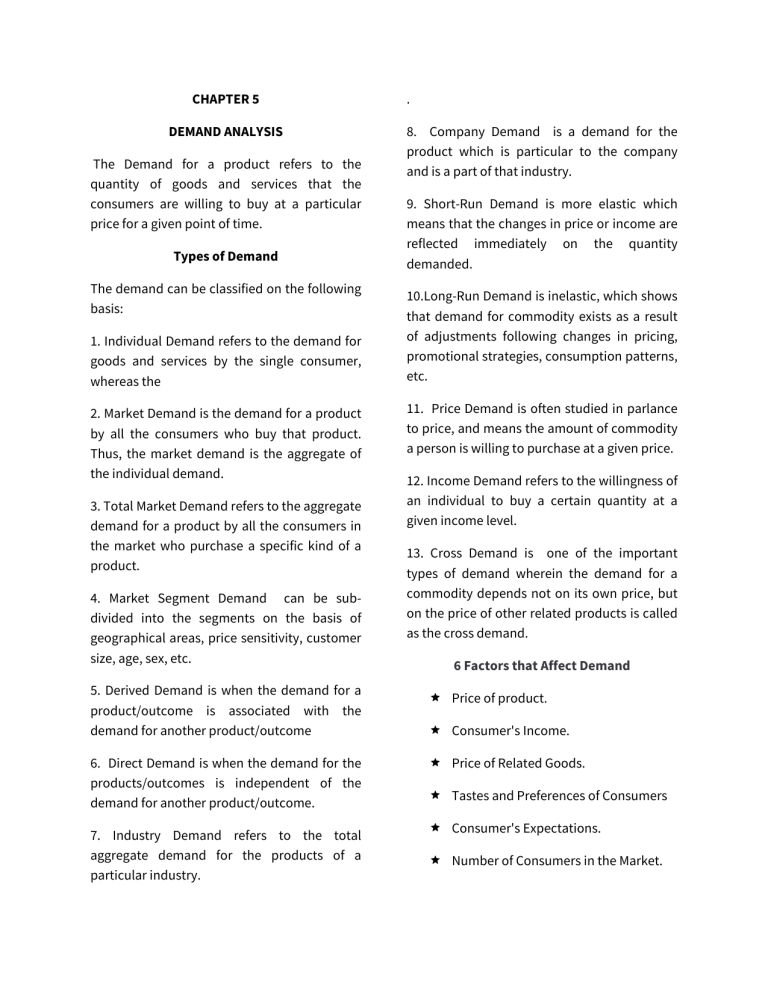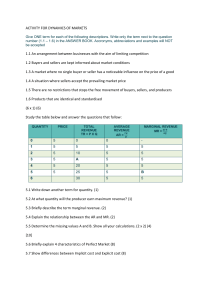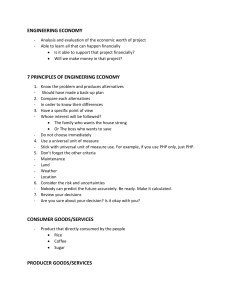
CHAPTER 5 DEMAND ANALYSIS The Demand for a product refers to the quantity of goods and services that the consumers are willing to buy at a particular price for a given point of time. Types of Demand The demand can be classified on the following basis: 1. Individual Demand refers to the demand for goods and services by the single consumer, whereas the 2. Market Demand is the demand for a product by all the consumers who buy that product. Thus, the market demand is the aggregate of the individual demand. 3. Total Market Demand refers to the aggregate demand for a product by all the consumers in the market who purchase a specific kind of a product. 4. Market Segment Demand can be subdivided into the segments on the basis of geographical areas, price sensitivity, customer size, age, sex, etc. 5. Derived Demand is when the demand for a product/outcome is associated with the demand for another product/outcome 6. Direct Demand is when the demand for the products/outcomes is independent of the demand for another product/outcome. 7. Industry Demand refers to the total aggregate demand for the products of a particular industry. . 8. Company Demand is a demand for the product which is particular to the company and is a part of that industry. 9. Short-Run Demand is more elastic which means that the changes in price or income are reflected immediately on the quantity demanded. 10.Long-Run Demand is inelastic, which shows that demand for commodity exists as a result of adjustments following changes in pricing, promotional strategies, consumption patterns, etc. 11. Price Demand is often studied in parlance to price, and means the amount of commodity a person is willing to purchase at a given price. 12. Income Demand refers to the willingness of an individual to buy a certain quantity at a given income level. 13. Cross Demand is one of the important types of demand wherein the demand for a commodity depends not on its own price, but on the price of other related products is called as the cross demand. 6 Factors that Affect Demand Price of product. Consumer's Income. Price of Related Goods. Tastes and Preferences of Consumers Consumer's Expectations. Number of Consumers in the Market. DEMAND ANALYSIS Demand analysis is the research conducted by companies that aim at understanding customer demand for a certain product. Businesses generally use it to determine whether they can successfully enter the market and obtain the expected profit. During this process, the management decides on cost allocation, production, advertising, pricing, etc. Demand analysis techniques allow entrepreneurs to determine the main business areas with the highest demand. Low demand for a specific product indicates that it does not fulfill customers' needs and perhaps has little value for them. Causes of Low Demand Incompatibly of products with the market Poor digital marketing Competitors alternatives that offer better Objectives of Demand Analysis ● Evaluating customers' response towards a product. ● Formulating a pricing policy. ● Sales forecasting. ● Establishing a production policy. How to Do Demand Analysis? 1. Identify the market. 2.Assess the business cycle. 3. Create a product that meets a particular niche. 4. Define your advantage. 5.Determine your competitors. Steps in any total-market forecast: 1.Defining the Market 2. Dividing Demand into Component Parts 3. Forecasting the Drivers of Demand 4. Conducting Sensitivity Analyses A credible sensitivity analysis typically has five (5) steps 1. Identify key cost drivers, ground rules, and assumptions for sensitivity testing; 2. Re-estimate the total cost by choosing one of these cost drivers to vary between two set amounts; for example, maximum and minimum or performance thresholds; 3. Document the results; 4. Repeat 2 and 3 until all factors identified in step 1 have been tested independently; 5. Evaluate the results to determine which drivers affect the cost estimate most. 6. Determining an Appropriate Effort Why is demand analysis important? A company's success or failure depends on the ability to identify and satisfy customers' needs. In today's market, every business needs to understand consumer behavior and hold inventory accordingly. Demand analysis brings many insights essential for the decision-making process. After conducting research, companies obtain knowledge crucial for sales forecasting, product pricing, costs on marketing and advertising, financial decisions, and production. CHAPTER 6 MARKET FAILURE Market failure is the economic situation defined by an inefficient distribution of goods and services in the free market. In market failure, the individual incentives for rational behavior do not lead to rational outcomes for the group. ● Market failure occurs when individuals acting in rational self-interest produce a less-thanoptimal or economically inefficient outcomes. ● Market failure can occur in explicit markets where goods and services are bought and sold outright, which are thought of as typical markets. ● Market failure can also occur in implicit markets as favors and special treatment are exchanged, such as elections or the legislative process. ● Market failures can be solved using private market solutions, government-imposed solutions, or voluntary collective actions. Causes of Market Failures 1. Externality refers to a cost or benefit resulting from a transaction that affects a third party that did not decide to be associated with the benefit or cost. A positive externality provides a positive effect on the third party. On the other hand, a negative externality is a negative effect resulting from the consumption of a product, and that results in a negative impact on a third party. 2. Public goods are goods that are consumed by a large number of the population, and their cost does not increase with the increase in the number of consumers. a. Non-rivalrous consumption means that the goods are allocated efficiently to the whole population if provided at zero cost. b. Non-excludable consumption means that the public goods cannot exclude non-payers from its consumption. Public goods create market failures if a section of the population that consumes the goods fails to pay but continues using the good as actual payers. 3. Market control occurs when either the buyer or the seller possesses the power to determine the price of goods or services in a market. The power prevents the natural forces of demand and supply from setting the prices of goods in the market. On the supply side, the sellers may control the prices of goods and services if there are only a few large sellers (oligopoly) or a single large seller (monopoly). On the demand side, the buyers possess the power to control the prices of goods if the market only comprises a single large buyer (monopsony) or a few large buyers (oligopsony). If there is only a single or a handful of large buyers, the buyers may exercise their dominance by colluding to set the price at which they are willing to buy the products from the producers. The practice prevents the market from equating the supply of goods and services to their demand. 4. Imperfect information in the market. Market failure may also result from the lack of appropriate information among the buyers or sellers. This means that the price of demand or supply does not reflect all the benefits or opportunity cost of a good. The lack of information on the buyer’s side may mean that the buyer may be willing to pay a higher or lower price for the product because they don’t know its actual benefits. On the other hand, inadequate information on the seller’s side may mean that they may be willing to accept a higher or lower price for the product than the actual opportunity cost of producing it. Solutions to Market Failures 1. Use of legislation - One of the ways that governments can manage market failures is by implementing legislation that changes behavior. For example, the government can ban cars from operating in city centers, or impose high penalties to businesses that sell alcohol to underage children, since the measures control unwanted behaviors. 2. Price mechanism - Price mechanisms are designed to change the behavior of both the consumers and producers. For products that cause harm to consumers, the government can discourage their consumption by increasing taxes. Is poverty a market failure? Poverty is considered to be a result of market failure. When a recession hits, the poverty rate increases because employees lose their jobs or lose working hours, which results in no income or less income, respectively. Inequality, which is a component of market failure, can eventually lead to poverty when wealth is not distributed equally throughout society. This can be remedied with government intervention, such as by taxing the wealthy more or incorporating subsidies for those below the poverty level.







